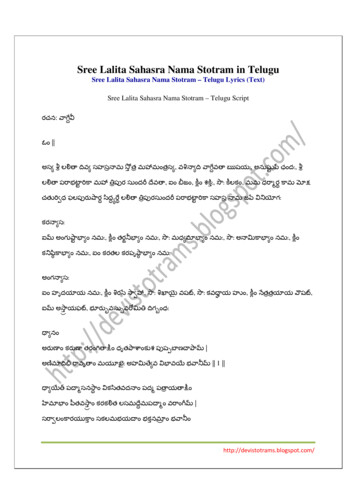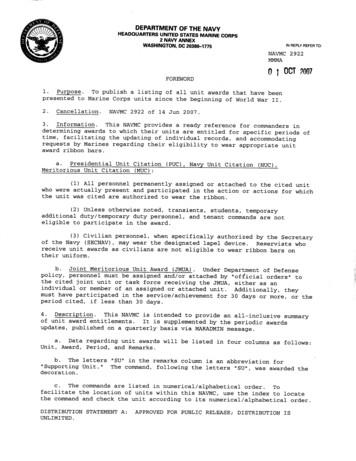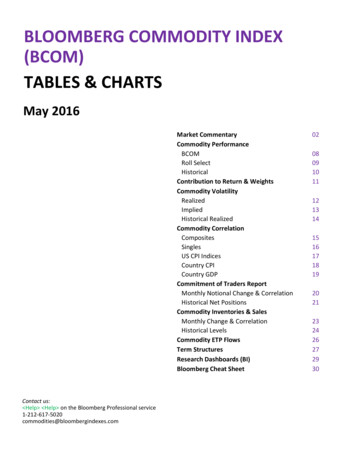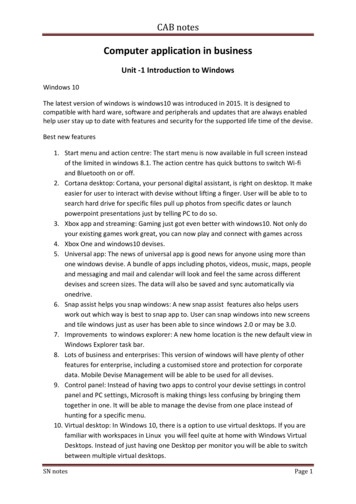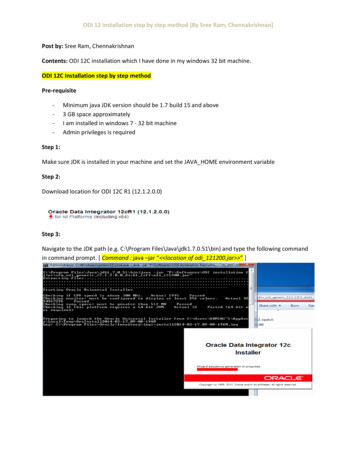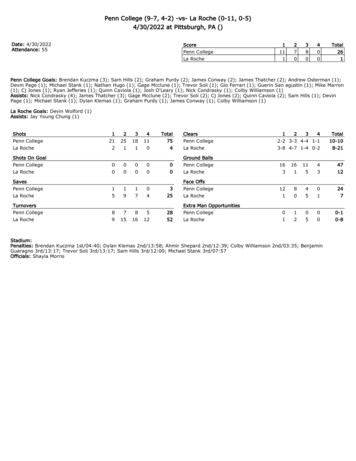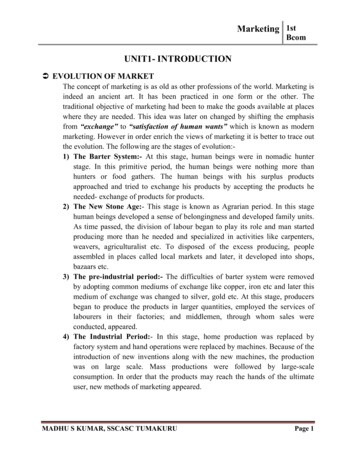
Transcription
Marketing 1stBcomUNIT1- INTRODUCTION EVOLUTION OF MARKETThe concept of marketing is as old as other professions of the world. Marketing isindeed an ancient art. It has been practiced in one form or the other. Thetraditional objective of marketing had been to make the goods available at placeswhere they are needed. This idea was later on changed by shifting the emphasisfrom “exchange” to “satisfaction of human wants” which is known as modernmarketing. However in order enrich the views of marketing it is better to trace outthe evolution. The following are the stages of evolution:1) The Barter System:- At this stage, human beings were in nomadic hunterstage. In this primitive period, the human beings were nothing more thanhunters or food gathers. The human beings with his surplus productsapproached and tried to exchange his products by accepting the products heneeded- exchange of products for products.2) The New Stone Age:- This stage is known as Agrarian period. In this stagehuman beings developed a sense of belongingness and developed family units.As time passed, the division of labour began to play its role and man startedproducing more than he needed and specialized in activities like carpenters,weavers, agriculturalist etc. To disposed of the excess producing, peopleassembled in places called local markets and later, it developed into shops,bazaars etc.3) The pre-industrial period:- The difficulties of barter system were removedby adopting common mediums of exchange like copper, iron etc and later thismedium of exchange was changed to silver, gold etc. At this stage, producersbegan to produce the products in larger quantities, employed the services oflabourers in their factories; and middlemen, through whom sales wereconducted, appeared.4) The Industrial Period:- In this stage, home production was replaced byfactory system and hand operations were replaced by machines. Because of theintroduction of new inventions along with the new machines, the productionwas on large scale. Mass productions were followed by large-scaleconsumption. In order that the products may reach the hands of the ultimateuser, new methods of marketing appeared.MADHU S KUMAR, SSCASC TUMAKURUPage 1
Marketing zed tralized Exchange MEANING AND DEFINITION OF MARKET The term ‘market’ is derived from Latin word called ‘marcatus’ which meanstrade, merchandise, traffic or place of business. In ordinary language, the term market refers to a certain place where buyersand sellers personally meet each other and make their purchases and sales. According to Cornot, “Market is meant not any particular place in whichthings are bought and sold, but the whole of any region in which the buyersand sellers are in such free intercourse with one another, that the price of thesame goods tends to equality easily and quickly”. According to Chapman, the term market refers “not to a place but to acommodity or commodities and buyers and sellers who are in directcompetition with one another”.MADHU S KUMAR, SSCASC TUMAKURUPage 2
Marketing 1stBcom According to W.J Stanton and Others, “Any person or group with whom anindividual or organization has an existing or potential relationship can beconsidered as market”. By analyzing the above definition we can define the term market refers to anexchange activity which takes place between buyers and sellers directly orthrough middlemen, in a place or otherwise, for a price, resulting in physicaldelivery of ownership of goods. MEANING AND DEFINITION OF MARKETING Marketing is a comprehensive term and it includes all resources and a set ofactivities necessary to direct and facilitate the flow of goods and services fromproducer to consumer in the process of distribution.Marketing is referred to a process of creating or directing an organization to besuccessful in selling a product or service that people not only desire, but arewilling to buy.The traditional meaning of marketing is clearly borne out by the definitiongiven by Ralf S. Alexander and Others, “Marketing is the performance ofbusiness activities that direct the flow of goods and services from the producer toconsumer or user”.The modern concept of marketing was defined by E.F.L. Breach as, “Marketingis the process of determining consumer demand for a product or service,motivating its sales and distributing it into ultimate consumption at a profit”.By analyzing the above definition we can define the term marketing as a businessprocess which creates and keep the customer.MADHU S KUMAR, SSCASC TUMAKURUPage 3
Marketing 1stBcom MARKETING ARENAThe word “ARENA” is derived from Latin word “HARENA” which meanssmooth or fine. Marketing arena is a process of composing of a large open spacesurrounded on most or all sides by varieties of products and brands.Marketing ArenaSeekingMatchingProgramminga. Seeking:- The purpose of seeking is to discover the customer and customerneeds. The marketing opportunity is revealed through an analysis of theenvironment.b. Matching:- Marketing is a matching process. Customer demand has to bematched with organizational resources and environmental limitations, such ascompetition, government regulations, general economic conditions and so on.c. Programming:- The marketing programme, called the marketing mix,covering product, price, promotion and distribution strategies will beformulated and implemented to accomplish the twin objectives of customersatisfaction and profitability. OBJECTIVES OF MARKETINGThe following are the most significant objectives of marketing and are:1) Creation of DemandThe objective of marketing is to create demand through various means. Aconscious attempt is made to find out the preferences and tastes of the consumers.Goods and services are produced to satisfy the needs of the customers. Demand isalso created by informing the customers the utility of various goods and services.2) Customer SatisfactionThe marketing manager must study the demands of customers before offeringthem any goods or services. Selling the goods or services is not that important asthe satisfaction of the customers’ needs. Modern marketing is customer-oriented.It begins and ends with the customer.MADHU S KUMAR, SSCASC TUMAKURUPage 4
Marketing 1stBcom3) Market ShareEvery business aims at increasing its market share, i.e. the ratio of its sales to thetotal sales in the economy. For instance, both Pepsi and Coke compete with eachother to increase their market share. For this, they have adopted innovativeadvertising, innovative packaging, sales promotion activities etc.4) Generation of ProfitsThe marketing department is the only department which generates revenue for thebusiness. Sufficient profits must be earned as a result of sale of want satisfyingproducts. If the firm is not earning profits, it will not be able to survive in themarket. Moreover, profits are also needed for the growth and diversification of thefirm.5) Creation of Goodwill and Public ImageTo build up the public image of a firm over a period is another objective ofmarketing. The marketing department provides quality products to customers atreasonable prices and thus creates its impact on the customers.6) Apply effective and intelligent modern marketing policiesChanging growth rate, rapid technological change and new aggressive rivals allmade every marketing firm to adopt and respond to change for survival andprosperity. So it is necessary for the firms to scrutinize its expenditure and makemaximum profits by adopting themselves to viable and matching methodologies,techniques and practices. For example, Time Management, Just-in-time etc. IMPORTANCE OF MARKETINGMarketingTowards SocietyRaise Standard of LivingTowards CompanyHelps in transfer & movement ofgoodsCreates EmploymentSource of RevenueDevelopment of EconomySource of New IdeasMADHU S KUMAR, SSCASC TUMAKURUPage 5
Marketing 1stBcomA. TOWARDS SOCIETY1) Helpful in raising and maintaining the standard living of the communityMarketingMarketing is the creation and delivery of standard of living to the society bymaking available the uninterrupted supply of goods and services to consumers at areasonable price. Society comprises of three classes of people i.e. rich, middle andpoor. Everything which is used by these different classes of people is supplied bymarketing.2) Creates EmploymentMarketing is complex mechanism involving many people in one form or the other.The major marketing functions are buying, selling, financing, transport,warehousing, risk bearing etc. In each such function different activities areperformed by a large number of individuals and bodies. Thus, marketing givesemployment to many people.3) Helpful in Development of an EconomyMarketing is the key to sets the economy revolving. The marketing organization,more scientifically organized, makes the economy strong and stable, the lesser thestress on the marketing function, the weaker will be the economy.B. TOWARDS COMPANY4) Helps in Transfer, Exchange and Movement of goodsMarketing makes goods and services available to customers through variousintermediaries like wholesalers and retailers etc. Marketing is helpful to bothproducers and consumers.5) Source of Income and RevenueMarketing generates revenue by providing many opportunities in the process ofbuying and selling the goods, by creating time, place and possession utilities. Thisincome and profit are reinvested in the concern, thereby earning more profits infuture.6) Source of new ideasThe concept of marketing is a dynamic concept. It has changed altogether with thepassage of time. Such changes have far reaching effects on production anddistribution. With the rapid change in tastes and preference of people, marketinghas to come up with the unique products.MADHU S KUMAR, SSCASC TUMAKURUPage 6
Marketing 1stBcom APPROACHES OF MARKETINGThe following are the most significant approaches of marketing and are:1) Commodity ApproachIn this approach the focus of study is on specific commodity. Under this approachthe study focuses on the flow of a certain commodity and its journey from theoriginal producer right upto the final customer and it includes conditions ofsupply, nature and extent of demand, the distribution channels used etc.Agricultural products like wheat, jute, cotton represent the commodity approach.2) Institutional ApproachUnder this approach, the interest of marketer centers around the marketingagencies i.e. transport and service agencies viz., wholesalers, retailers, banks,transport undertakings, insurance companies etc., who participate in dischargingtheir marketing responsibilities during the movement of distribution of goods.3) Functional ApproachUnder this approach, marketer concentrates his attention on the specializedfunctions or activities like buying, selling, storage, risk bearing, transport, financeetc. These functions are also studies in relation to given commodities andmarketing institutions in terms of their operational methods and systems.4) Managerial ApproachThis approach is also known as Decision- making approach. The focus of thisapproach is on the decision-making process. The study encompasses discussion onplanning, organizing, controlling, directing etc. This approach is considered themost useful way of studying marketing activities.5) Societal ApproachThis approach focuses on the social contributions and costs created by variousmarketing activities and institutions. In this approach the focus of study will be onthe interactions between the various environmental factors and their impact on thewell-being of society.6) System ApproachThe approach recognizes the inter-relations and inter-connections among thecomponents of a marketing system in which products, services, money,equipments and information flow from marketers to consumers. The focus of thisapproach will be on the analysis of marketing flows and communication.MADHU S KUMAR, SSCASC TUMAKURUPage 7
Marketing 1stBcom MARKETING CONCEPT/PHILOSOPHY/ORIENTATIONAccording to Prof. Robert F Hartley, Marketing concept/philosophy/orientation is“an integration of marketing activities directed towards customer satisfaction”. Thismarketing philosophy undergone a thorough and gradual change since the IndustrialRevolution. This gradual change can be traced under four periods and are explainedbelow:1) Production Orientation PhilosophyThis production-oriented marketing concept was built on “Good wine needs nopush.” This philosophy states that if the product is really good and the price isreasonable, there is no need for special marketing efforts. The assumptions of thisconcept are: Anything that can be produced can be sold. The most important task of management is to keep the cost of productiondown. A firm should produce only certain basic products.GoodProductGood Sales2) Sales Orientation PhilosophyThe essence of this philosophy is “Goods are not bought but sold.” That meansmere making available the best product is not enough; marketing becomes fruitfulonly when they get into aggressive salesmanship. Effective advertisement, salespromotion and public relations etc are top most important for creating demand.The assumptions of this philosophy are: Producing the best possible product. Finding the buyer for the product. The management’s main task is to convince the buyers through highpressure tactics, if necessary.ProductPromotionMADHU S KUMAR, SSCASC TUMAKURUSalesPage 8
Marketing 1stBcom3) Customer Orientation PhilosophyThis philosophy study and understand the needs, wants, desires and values ofpotential consumers and produce the goods in the light of these findings so thatconsumer specifications are met totally. Here, the staring point is the customerrather than the product and it also emphasis the role of marketing research. Theassumptions of this philosophy: The firm should produce only that product as desired by the consumer. The management is to integrate all its activities in order to developprogrammes to satisfy the consumer wants. The management is to be guided by ‘long-range profit goals’ rather than‘quick otionSales4) Social Orientation PhilosophyThis philosophy cares for not only consumer satisfaction but for consumer welfareor social welfare. Such social welfare speaks of pollution-free environment andquality of human life. For example, an automobile not only fuel efficient but lesspollution one. The assumptions of this philosophy are: The firm is to produce only those products as are wanted by the consumers. The firm is to be guided by long-term profit goals rather than quick sales. The firm should discharge its social responsibilities. The management is to integrate the firm’s resources and activities todevelop programme to meet these individual consumer and social needs.CustomerMarketingResearchMADHU S KUMAR, SSCASC TUMAKURUR and DProductSalesPromotionSalesPage 9
Marketing 1stBcom DIFFERENCES BETWEEN SELLING AND MARKETINGSl.No.1SellingMarketing4Selling is mere the exchange of goods Marketing is more comprehensivefor money between the seller & the term. It includes not only selling butbuyeralso all other activities which helpthe movement of goods from thecenter of production to the center ofconsumptionSelling comes at the end of the Marketing comes at beginning of themanufacturing cyclemanufacturing cycleSelling is concerned with the creation Marketing is concerned with creationof mere possession or ownership of place, time and possession utilityutilitySelling focuses on the productMarketing focuses on the customers5Selling is product-OrientedMarketing is Consumer-Oriented6It emphasis on the needs of SellersIt emphasis on the needs of Buyers23MADHU S KUMAR, SSCASC TUMAKURUPage 10
Marketing 1stBcom DIFFERENCES BETWEEN TRADITIONAL AND MODERNMARKETINGSl.No.Traditional MarketingModern Marketing1It is concerned with the performanceof activities necessary to secure thedistribution and sale of goods whichthe producer has2It focuses on sellers needs as it isSales-Oriented MarketingIt is concerned with theperformance of activities necessaryto secure the distribution and saleof goods as are needed by theconsumerIt focuses on consumers’ needs as itis Consumer-Oriented Marketing3The selling efforts of a concern areCompany-OrientedThe selling efforts of a concern areMarket-Oriented4It aims at profit through increasedsales volume i.e. more sales5It aims at short-term objectives i.e.short-term profitsIt aims at profit through increasedsales to the satisfaction of theconsumers and profit to the sellersIt aims at long-term objectives i.e.long-term profits6It can be successful only in a countrywhere there is a seller’s marketMADHU S KUMAR, SSCASC TUMAKURUIt can be successful only in acountry where there is a buyer’smarketPage 11
Marketing 1stBcom FUNCTIONS OF MARKETINGFUNCTIONSFunctions of Exchange1. BUYINGa. Planningb. Contractualc. Assemblingd. Negotiation2. SELLINGa. Product Planningb. Contractualc. Demand Creationd. NegotiationFunctions of PhysicalSupply1. Transportation2. StorageFacilitating Functions1.2.3.4.5.6.7.8.9.FinancingRisk BearingMarket SalesmanshipAdvertisingA. FUNCTIONS OF EXCHANGE1. BUYINGBuying is one of the functions of exchange that refers to all such activities in theassembling of goods, under a single ownership and control. This function involvesthe following:a) Planning: The buyers must plan in order to determine their needs. Businessbuyers must study their own markets to know the quantity and quality of goodsthat are required by final users.b) Contractual: This involves finding out the sources of supply, keeping in touchwith them, to get the goods quickly, reasonably, sufficiently and regularly.c) Assembling: This is one of the important functions where goods produced atdifferent places must be assembled in order to serve promptly the needs ofmanufacturers, wholesalers, retailers and consumers.d) Negotiation: The terms and conditions of purchase are negotiated with theseller. After this final agreement are made & the transfer of titles take place.MADHU S KUMAR, SSCASC TUMAKURUPage 12
Marketing 1stBcom2. SELLINGSelling is the sum total of all those activities that push the commodities to thebuyers at a profitable price. This includes the following:a) Product Planning: Product-planning refers to planning or forecasting ofconsumer wants and desires in terms of price, quality, quantity, time etc to meetthe requirements of consumers as demanded by them.b) Contractual: In this function, the seller finding out and locating the consumersand establishing and maintaining relation with them.c) Demand Creation: This includes all efforts of sellers to induce buyers topurchase their products. In order to increase sales, demand creational effortslike personal selling, advertising etc are undertaken by seller.d) Negotiation: Negotiations as to terms of quality, quantity, price of the product,time and mode of transport, payments etc are to be made with the prospectivebuyers.B. FUNCTIONS OF PHYSICAL SUPPLY1) Transportation: Transportation refers to the physical movement of goods fromplaces of production to places of consumption. The transport function ofmarketing involves the selection of particular mode of transport, depending uponthe speed and cost.2) Storage: Storage refers to the holding and preserving of goods between the time oftheir production and the time of their sale. It facilitates the steady and continuousflow of commodities to the market throughout the year and it also helps to adjustthe supply of goods to the demand.C. FACILITATING FUNCTIONS1) Financing: The service of providing the credit and money needed to meet thefinancial requirements of the various agencies engaged in the various marketingactivities. Even though finance smoothens the process of exchange and acts as alubricating oil to the wheel of marketing.2) Risk Bearing: Marketing involves a number of risks. The risk may be loss ofgoods due to fire, flood, cyclone, earthquake, theft etc. Some of this risk can beavoided through proper planning like insurance and hedging.3) Market Information: The function of marketing information refers to thecollection, analysis and interpretation and communication of marketinginformation to the concerned people for efficient marketing.MADHU S KUMAR, SSCASC TUMAKURUPage 13
Marketing 1stBcom4) Standardization: Standardization is a measure of designation for quantity. Itconsists of list of specifications based on size, colour, appearance, shape, amountof moisture etc. In other words, it is refers to the act of grading.5) Pricing: Pricing is the process of determining the value of a product or service interms of money before it is offered to the market for sale.6) Branding: Branding is the process of identifying the name of a producer with hisproduct by affixing to the product the trade name represented by words or designs.For example, HUL branded Vanaspathi as DALDA.7) Packaging: Packaging is the use of containers and wrapping materials plusdecoration and labeling to protect the product, to help and promote its sales, and tomake it convenient for the customers to use the product. In short, it is the art ofdesigning and producing the package for a product.8) Salesmanship: Salesmanship is the process of understanding, appreciating andinfluencing customers to buy a commodity or service for mutual benefit.9) Advertising: Advertising means informing the public about the existence of aparticular product or service, stimulating their desire for the product or service andinducing them to buy the same. MARKETING ENVIRONMENT Marketing does not exist in vaccum. It exists in a world of concrete places andthings, natural resources, important abstractions, and living persons. It has tointeract and transact with its environment. The term Marketing Environment refers to the forces and factors that affect theorganization ability to built and maintain good relationship with its customers. In other words, marketing environment refers to “all those internal and externalfactors which impact the performance of a product or firm for its decisionmaking.”MADHU S KUMAR, SSCASC TUMAKURUPage 14
Marketing 1stBcomMarketing EnvironmentInternal environmentExternal environmentEthical ForceHuman ResourceMICROFinancial ResourceCompetitorDemographicProduction ResourceCustomerEconomicResearch & DevelopmentSupplierCulturalIntermediariesPolitical & LegalPublicTechnologicalWorkers & UnionNaturalMACROA. Internal EnvironmentThe internal environment is composed of the elements within the organization,including current employees, management, and especially corporate culture, whichdefines employee behaviour. Although some elements affect the organization as awhole, others affect only the manager.In other words, the internal environments are controllable factors because thecompany has control over these factors.1) Ethical Force: Almost every business conduct their marketing operations basedupon business ethics and morals which are all absolutely essential to establish apositive reaction in the marketing world. The business community must have theirethical responsibility while delivering the goods to the society otherwise it leads tonegative impression.2) Human Resource: The characteristics of human resource will also contribute tothe success or failure of business enterprise. Characteristics like employee skill,efficiency, attitude, perception, morale, risk-taking capacity etc may vary fromemployee to employee and from organization to organization. Training andmonitoring changing behaviour of employees is required to hold work efficiency.MADHU S KUMAR, SSCASC TUMAKURUPage 15
Marketing 1stBcom3) Financial Resource: Financial factors like financial policies, apparatus, financialposition and capital structure are also important internal elements affectingmarketing activities, performance strategies and decisions.4) Production Resource: Raw materials of the company and their utility also affectthe decision of the company. Productive capacity, technology and efficiency ofproductive apparatus, distribution logistics etc are all the factors influence thecompetitiveness of a business firm.5) Research and Development: Effective decision-making may be possible whenthere is a mind of innovation in the organization. In this fast moving corporateworld, it is needed for a company to make decisions to suit changing environmentand also for sustain ability of the organization for a prolong period.B. External EnvironmentThe external environment is composed of all the outside factors or influences thatimpact the operation of business. The business must act or react to keep up the flow ofoperations.In other words, they are generally uncontrollable factors because the factors arebeyond the control of the company.The external environment can be divided into two types: Micro environment Macro environmenti.MICRO ENVIRONMENTMicro environment is also called as a task and operating environment where itstudies the small part or individual unit of the business. It includes:1) CompetitorsNo company can enjoys monopoly in this business world. Today’s competitiveenvironment consists of certain basic things which every firm has to take note of.A firm’s competitors’ includes not only the other firms in which they also marketthe similar products but also those who compete for the discretionary income ofthe consumers. Competition has two different sense in today’s market and are:Brand Competition, for example, Philips TV faces competition from othercompanies like Videocon, Onida, BPL etc this is called brand competition.Product form competition, for example, if consumer wants to purchase twowheeler, the next question in his mind is with gear or without gear; self-starter orquick-starter etc this is called product form competition.MADHU S KUMAR, SSCASC TUMAKURUPage 16
Marketing 1stBcom2) CustomersAccording to Peter.F.Drucker, “there is only valid definition of business purpose,that is to create a customer” and thus the major task of a business is to create andsustain customers because business exists only because of its customers.Customers may be of difference categories like individuals, households, industriesand other commercial establishments and government. Monitoring the customersensitivity leads to business success.3) SuppliersSuppliers are those who supplies the inputs to the company. Supplier behaviourand attitude may also affect the company. Hence, multiple sources of supply oftenhelp to reduce such risks of the business concern. For example, Toyota alwayshave some precautionary measure on suppliers so they prints “Suppliers Guide.”4) Marketing intermediariesIt includes middlemen such as agents and merchants who help the company to findcustomers and sell the product to them. They are vital links between the companyand the final consumers. A wrong choice or dislocation of the link may cost thecompany heavily. Both the company and the intermediary are responsible for thefollowing aspects: The company should review the performance of middlemen periodically. Middlemen always help the company to overcome the discrepancies inquantities, place, time and possession.5) PublicLiterally word ‘public’ refers to people in general. According to Philip kotler, “Apublic is any group that has an actual or potential interest in or impact on acompany’s ability to achieve its objectives.” Companies must put their primaryenergy into effectively managing their relationships with their various public likesupplier, customer, media, competitor, distributors, investors, bankers etc.6) Workers & their UnionWorkers are the pillars of the company. So the workers now prefer to join tradeunions where it protects their interests, improve their working conditions etc. fromthe company’s point of view, industrial relation is more important to improve thecompany, otherwise conflict between labour and management leads to sick unit.MADHU S KUMAR, SSCASC TUMAKURUPage 17
Marketing 1stBcomii.MACRO ENVIRONMENTIt is also known as general or remote environment. It studies the larger part of thebusiness in general.a) DemographicDemographic environment is the study of human population in terms of its size,density and distribution. This includes age, sex, martial status, ethnic status etc.b) EconomicMarketing depends on the economic environment to sell the finished goods.Inflation, vary interest rates, supply of money, demonetization etc will influencethe demand and willingness for a product.c) CulturalCulture is understood as that complex whole which includes knowledge, belief,art, morals, law, customs and other capabilities and habits acquired byindividual as a member of a society.For example: American brand of car named “NOVA” in Spanish it means“STAR” but in spoken it means “DOESNOT GO OR COME ALIVE”. Due tothe public demand the named get changed.d) Political and legalThis factor influences the operations of marketing, which includes governmentregulations, policies, declaration, nature of constitution etc. For example: USAattracts international traders through its political stability and dynamicgovernment.a) TechnologicalAccording to J K Galbraith, a technology is a “systematic application ofscientific or organized knowledge to practical tasks.The company engaged with the innovations, inventions and findings let them toimplement their business ideas and which results to profit and growth.b) NaturalManufacturing is one of the essential part of the marketing activities in which ittotally depends on the natural environment for its inputs like raw materials,water, fuel etc.MADHU S KUMAR, SSCASC TUMAKURUPage 18
Marketing 1stBcom MARKET SEGMENTATION Market Segmentation is the strategy of ‘divide’ and ‘conquer.’ i.e. dividing themarket in order to conquer them. So, it is
Marketing 1st Bcom MADHU S KUMAR, SSCASC TUMAKURU Page 1 UNIT1- INTRODUCTION EVOLUTION OF MARKET The concept of marketing is as old as other professions of the world. Marketing is indeed an ancient art. It has been practiced in one form or the other. The traditional objective of marketing had been to make the goods available at places
